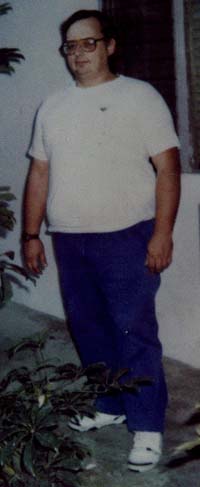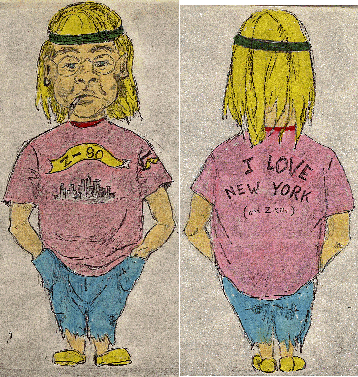
Kevin Kenney is a veteran computer programmer, being in the biz since the late '70s. He's produced titles on a variety of classic and contemporary platforms including: TI-99/4A, Commodore 64, Commodore Vic-20, Apple ][, Sigma 9, and mainframe computers. Kevin graciously accepted my invitation for conducting an interview in the winter of 2002.
Ed Burns: Can you give me some resume details? Where did you go to school, what kind of computer training did you have, how did you come to work at TI?
Kevin Kenney: I was an egghead in high school, testing quite high on the mathematics side. I got into Chemistry by being a Mr. Wizard fan as a kid. As an undergraduate in college, I got into computers, and ended up doing Computer-Aided Instruction programs for the colleges of Chemistry, Biology, and Physics; even ending up as a Teaching Assistant for some Engineering Chemistry courses (for Dr. Earl Krakower, as well as Terrence Morrill). Took a few computer classes along the way, sometimes telling new professors the differences between the text and the system in use, and having some of my computing requirements waived.
EB: Very impressive that RIT even had computing requirements back then!
KK: (Off topic: In high school & early college, I was into probability, and wondered the chance of landing on Boardwalk on any given circuit of a Monopoly board (minus card effects, etc.). One of my earliest programming projects was to find out, and I devised the formula to give the number of ways to role a given number on X Y-sided dice, for any X and Y. Plugging this into a large HP desktop programmable calculator, I came up with the common sense result: since the average roll is 7, the chance to hit a space tends towards 1/7th as the number of spaces away increases. I might have published this, but lacked the mathematical notation experience to properly write out the formula.)
A previous alum (Brad) checked with the professors he had had at RIT to see if anyone interesting was about to graduate, and I was pointed out. TI was my first interview, and I got an offer during the interview. Given the choice of programming games or cleaning test tubes...
EB: [Laughs out loud] Was Brad a current TI employee? Did he work on games as well?
KK:I believe Brad was in systems or "serious" programming: I don't remember him doing any games. (Off topic: I remember one of my supervisors trying to get me to move to TI Dallas, saying I'd find systems programming similar to games programming...)
EB: HA! It certainly seems like a more stable job choice, but the work seems very different. Can you remember some of the other people you worked with at TI?
KK: (Ground rule: I'm hideous with names - I can remember faces, personalities, and events, but few names. Prepping for this interview, I found an office birthday party card. Some of the names on the card, and what I think I remember about them follow. (My apologies to all if I get names wrong (including spelling errors) and/or connected to memories incorrectly. Apologies also to those I wanted to mention, but couldn't remember the names of.)) [Editor's note: you can tell he's a programmer with the correctly nested parens. I wonder if he's done any LISP?]
The (partial) roster (as far as I can make them out from the card):
Don Bynum - manager - outgoing, affable, stereotypic friendly Texan type. Wonderful guy.
Bob Hensler (spelling?) - somewhat older gent, did Alpine Climber.
Carolyn Lee - educational/speech programmer. I think she was the one still working on a project the morning of the day she had a kid... (conflicting deadlines)
Donna - educational programmer. I still remember her reaction to my mentioning Kirk Douglas' nude scene in Saturn V... (a la "Kirk... Douglas...??? THE Kirk Douglas?")
Sue Hensley - manager of testing. Friendly, but with the strength of personality to get the job done well.
Jim Dramis - another good game programmer, more politically correct, who did may of the later games, as mentioned below.
Others from the card, I'm either less sure of the tasks of, or otherwise have no stories for I sure of enough to relate:
Dean Powell
Robert Herd - I did have a relatively good friend there, unfortunately with a common-enough name to make it hard to remember. This may have been him.)
Jim Ng
Mari Forseth
Susan Powell
Mary Lopez
Susan Gum
Terry Spacek
Bobby Mathers
John Acker (If I've got Jim Dramis wrong elsewhere, John is whom I may have confused him with.)
Jeanette, Allan, Roy, Debbie
Editor's note: That's a treasure trove of names above. Jim Dramis worked on with Paul Urbanus on the TI Game Parsec. You might notice some obvious self references in the game: the initials JED and URB in the landscape, and the fact that two of the enemy ship types are called Dramite and Urbite. You can find game credits for many of these names at James Hague's most excellent Giant List of Classic Game Programmers [1].
EB: How did you get into programming games?
KK: See above. I had been a member of the board Wargaming club, had probably been the first D&D dungeonmaster (brown-box days), and had translated Colossal Cave to run on the school's Sigma 9. So I was into games enough to make the transition.

| |
| Above: Kevin Kenney, during the 80's. |
EB: What was it like working at TI? What was the hacker culture there? Were programmers treated well there? Stock options? Free Soda? Free arcade machines? Were they full time TI employees, or contractors.
KK: None of the above. The closest thing to a hacker culture were the "I didn't work on the 99/4" buttons subversively distributed. Cubicle city, going from 4 programmers in a cube to tiny one-person cubes. All full-time (though see below).
A story. I was into Yoga and foreign films in college, and continued both pursuits in Lubbock. Yoga was at the YWCA, which a female instructor that also taught at Texas Tech. One day while leaving the class, she was telling me about a film series at the college, as she met her husband. The introduction went something like:
She: This is Kevin. He works out at TI.
He: Oh, which division?
Me: Home computers.
He: Oh, MY division. (It was Pete Bonsfield.)
A couple of days later he called a staff meeting to meet all the new hires, and relate, as a joke, how he had met me while I was discussing French films with his wife...
EB: According to the TI Timeline [2], TI made the mistake of laying you off right after you finished ToD. Is this true? Is there any interesting story there? Was this part of a round of layoffs, or was it a bone-headed management decision?

| |
| Above: The sketch of the liberal Mr. Kenney, expressing his love for New York and Z-80's. |
KK: The timeline's correct. One reason was that ToD took over a year to program. Another may have been my liberal political bent. (I still have a sarcastic sketch someone made of me as a left-wing radical hippie type.) Then I had also backgammoned my supervisor at the previous Christmas office party. Mine was part of a larger layoff. TI did then contract with me to do additional databases for ToD, and only one (with a 'spy' motif: find blueprints instead of gems) had been completed but never released. (My 99/4 gave up the ghost a ways back, and during some space-constrained move I got rid of my copies. Perhaps if I had seen emulators coming...) My working title was 'Spy Guy'.
EB: Was it really conservative at TI, and in Lubbock in the early eighties?
KK: As a college town, not really. The town was dry, and thus ringed with liquor stores (and non-safe-and-sane fireworks booths). There was probably more flak for my being a Yankee instead of a Democrat.
Conservatism was the rule in the games though. I had to battle to get the deaths left in Wumpus, especially flashing the screen to pure red should you stumble into the Wumpus's lair. Way too shocking for some. (Trivia: Did you notice the French translation for 'Slime' when you fell in a pit was 'Mousse'?)
EB: It's hard to believe they balked at the goriness of Wumpus. What would they have thought of Quake? How stodgy! What was the dress code at TI? Did you have to wear a tie?
KK: The facility was a manufacturing one, so jeans to business casual was the rule.
EB: Was there a camaraderie among all the programmers?
KK: A fair degree. I remember us all getting along regardless of politics.
EB: Did you or any of your programming compatriots ever wish they were in Silicon Valley?
KK: Not I. Too much competition. After TI, I worked for a toy consultation firm during the Atari 2600 boom/bust cycle, and did a little work for Epyx, that gave me a taste of the culture there.
EB:Regarding the boom bust cycle, what was your personal experience with the great video game crash in the early eighties?
KK: Watched it at the consulting firm mentioned above, which had enough other projects to see me through. I then got into scientific programming: chemical instrumentation control and analysis. Still doing serious stuff, still playing games on the side.
EB: What is the complete list of games for which you were the primary author?
KK: Tunnels of Doom, Hunt the Wumpus, A-Maze-ing; though the latter two were picked up from elsewhere and greatly expanded on. After TI, I did programming or design on some smaller stuff for various consoles such as Hot Wheels, Congo Bongo (non-arcade), and one arcade machine for Mylstar called Stamp Them Ants, that never saw wide release, as Mylstar went under. The commercial for VCS Congo Bongo featured footage of the game as I played it (offscreen). (My closest brush with fame.) These latter games were for A. Eddy Goldfarb & Associates, 'creators to the toy industry', who designed many of the top products (toys, dolls, games) for many game companies.
EB: Non-primary author?
KK: I did a lot of work on The Attack, including play-balancing, its theme song and sound effects. Suggestions for others. Spent some time doing input routines for TIRK.
EB: What is TIRK?
KK: Tax & Investment Record Keeping.
EB: Did you make any contributions to other titles?
KK: I tested and made suggestions on a lot of the game titles, probably having the most effect on our Pac-Man and Space Invaders rip-offs. (Both primarily programmed by the same guy, I think Jim Dramis. He gets the vast majority of the credit, including for occasionally listening to me. He was our other 'best' game programmer, and did surpass me, partially due to working in assembly instead of GPL.)
EB: For what platform did you work on Congo Bongo? How was it different programming that platform from working on the TI?
KK: C-64, Vic-20(?). A VCS version was done by another company that worked with Goldfarb's. Though I don't remember doing any significant programming on Congo-Bongo, I did do the original screen translations (when Sega's brass saw the same screens on all the systems, we we're in), and some light algorithm, and balancing stuff.
All the home-system games were developed on Apple ]['s. Prom-burning without emulators, so you had to add your own debugging code.
[ Part II ] [ home ]